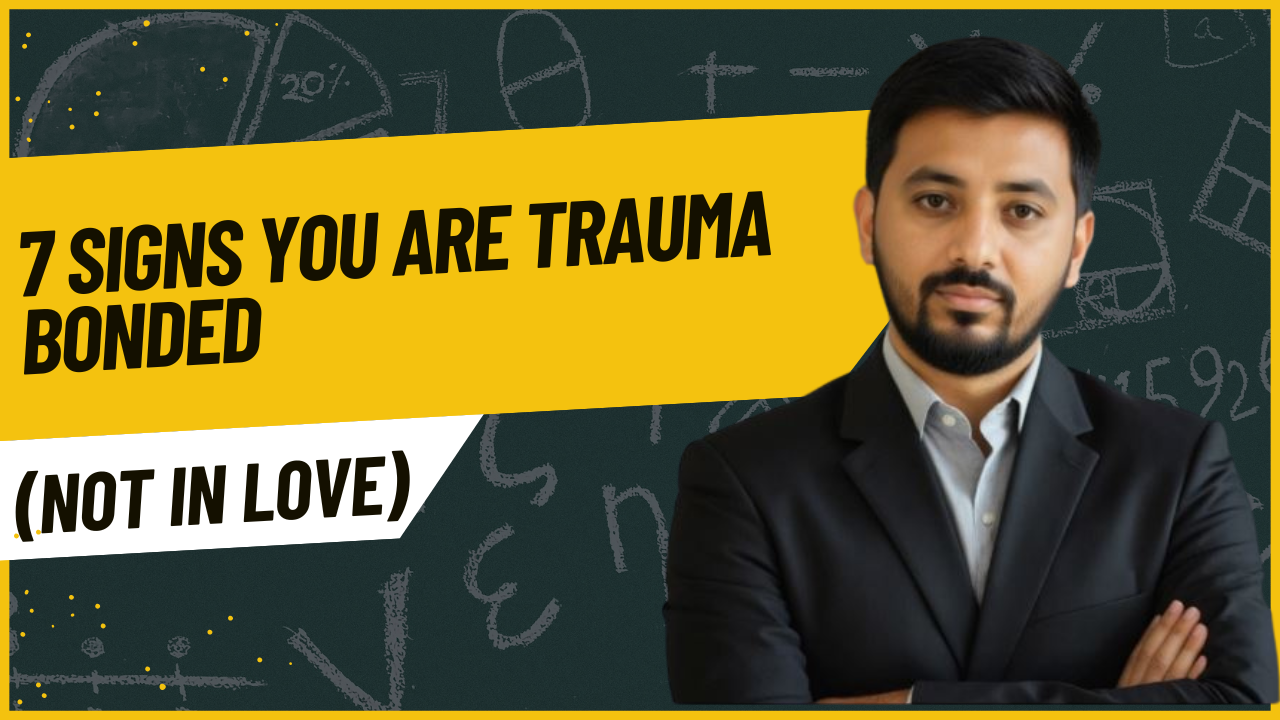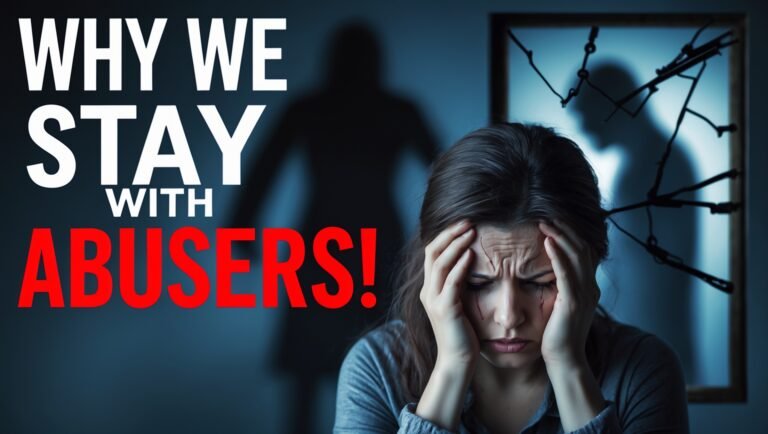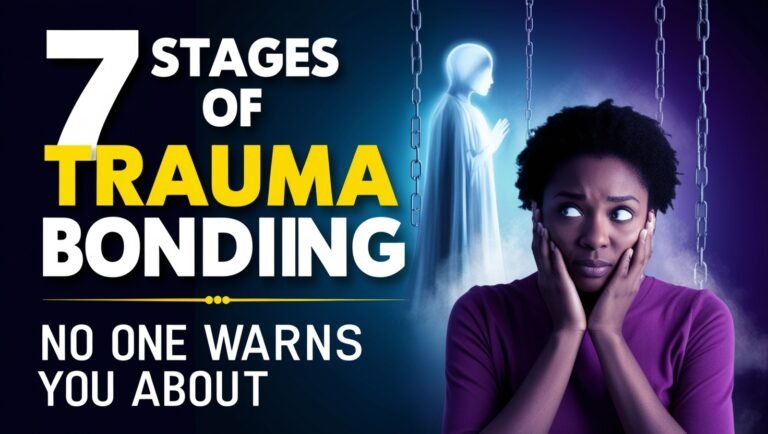7 Signs You Are Trauma Bonded (Not In Love)
The voice message arrives at 2 AM. You promised yourself you wouldn’t answer this time, but your heart races as you reach for the phone. Despite the tears, broken promises, and the friends who’ve stopped inviting you places, something powerful pulls you back into the cycle. “It’s love,” you tell yourself. “It’s complicated, but worth fighting for.”
But what if what you’re experiencing isn’t love at all? If you’re searching for signs you are trauma bonded, you’ve taken the first crucial step toward understanding your relationship dynamics. Recognizing the difference between trauma bonding and love is essential for breaking free from unhealthy attachment patterns. What psychologists call a trauma bond often masquerades as intense love, but operates through entirely different psychological mechanisms.
Trauma bonding is one of psychology’s most misunderstood phenomena – a powerful emotional attachment formed through repeated cycles of abuse, tension, and reward. Unlike healthy relationships built on mutual respect and consistent support, trauma bonds are forged in the fire of emotional extremes, creating an addiction-like dependency that can be harder to break than a chemical dependency.
In this comprehensive guide, we’ll explore the seven critical signs that distinguish trauma bonding from genuine love, why these bonds form, and most importantly, how to break free and heal if you recognize these patterns in your own relationship.
What Is Trauma Bonding? Understanding the Psychology
Trauma bonding occurs when a person develops an attachment to someone who is a source of both pain and relief in their life. The term was first popularized by Patrick Carnes, who defined it as “the misuse of fear, excitement, sexual feelings, and sexual physiology to entangle another person.”
The Science Behind Emotional Addiction
At its core, trauma bonding is biochemical. When we experience the highs and lows of an abusive relationship, our brains release a cocktail of chemicals including:
- Dopamine during the “honeymoon” or reconciliation phases, creating pleasure and reinforcement
- Cortisol and adrenaline during stressful or abusive episodes
- Oxytocin during moments of intimacy and apparent bonding
This biochemical rollercoaster creates a powerful addiction cycle. According to a study published in the Journal of Traumatic Stress, these neurochemical patterns can mirror those seen in substance addiction, making trauma bonds extraordinarily difficult to break.
Dr. Bessel van der Kolk, a leading trauma researcher, explains: “The body keeps the score. Our biochemistry drives us to seek out what is familiar, even when it’s harmful.”
Understanding the Difference Between Trauma Bonding and Love
Before diving into the specific signs you are trauma bonded, it’s essential to understand how trauma bonds fundamentally differ from healthy relationships. The difference between trauma bonding and love is profound and impacts every aspect of the relationship:
| Trauma Bond | Healthy Relationship |
| Intense emotional highs and lows | Consistent emotional support |
| Fear of abandonment | Security and trust |
| Walking on eggshells | Open communication |
| Identity loss | Personal growth encouraged |
| Isolation from support network | Healthy external relationships maintained |
Now, let’s examine the seven telltale signs that indicate you may be caught in a trauma bond rather than experiencing genuine love.
Sign #1: Intense Emotional Highs and Crashes
Perhaps the most defining characteristic of a trauma bond is the relationship’s extreme emotional volatility.
The Addictive Cycle of Intensity
In trauma-bonded relationships, you likely experience emotional states that swing between euphoria and despair. When things are good, they feel transcendent—the connection seems deeper and more meaningful than anything you’ve ever experienced. When things are bad, the pain feels unbearable.
Dr. Alexandra Pierce, clinical psychologist specializing in relationship trauma, notes: “This isn’t the natural ebb and flow of a healthy relationship. It’s more like emotional whiplash, and it creates a psychological dependency.”
Intermittent Reinforcement: The Strongest Behavioral Conditioner
The unpredictable nature of rewards in a trauma bond makes it particularly addictive. Psychologists call this “intermittent reinforcement”—the most powerful form of behavioral conditioning.
Consider a study from animal behavior research: rats press a lever more persistently when rewards come unpredictably than when they come consistently. Similarly, when affection, approval, and kindness come unpredictably in a relationship, we become more, not less, attached to the source.
Real-life example: Sarah describes her relationship: “When he was loving, he was the most attentive, romantic person I’d ever met. But I never knew what might trigger his anger or when he’d disappear for days. I lived for those good moments, even though they were increasingly rare.”
Sign #2: Making Excuses for Abusive or Neglectful Behavior
A hallmark of trauma bonding is the extensive rationalization of harmful behavior.
Cognitive Dissonance in Action
When we care deeply about someone who also hurts us, we experience cognitive dissonance—the discomfort of holding two contradictory beliefs. To resolve this discomfort, trauma-bonded individuals typically adjust their perception of reality rather than confronting the painful truth.
Red Flags Disguised as Depth
You might find yourself saying things like:
- “He’s just passionate—that’s why he gets so angry.”
- “She had a difficult childhood, so I need to be patient when she lashes out.”
- “Our connection is so intense that normal relationship rules don’t apply.”
- “No one understands what we have together.”
According to the National Domestic Violence Hotline, this type of rationalization is present in 85% of abusive relationships.
External Validation and Reality Testing
Friends and family often notice the unhealthy patterns long before those in the relationship do. If people who care about you express concern, it may be worth considering their perspective.
A study by the American Psychological Association found that social support is a critical factor in helping people recognize and leave unhealthy relationships. Unfortunately, many trauma bonds lead to isolation from these crucial support networks.
Sign #3: Persistent Hope Despite Evidence to the Contrary
Hope can be a beautiful thing—except when it keeps you tethered to a harmful situation.
The False Promise of Potential
In trauma bonds, you’re not in love with the person as they consistently demonstrate themselves to be, but rather with their potential—who they could be or who they occasionally are.
Dr. Margaret Paul, relationship expert, explains: “When we’re addicted to potential, we’re in a relationship with a fantasy, not a real person.”
The Sunk Cost Fallacy
Many people remain in trauma bonds because they’ve already invested so much time, energy, and emotion. Psychologists call this the “sunk cost fallacy“—the irrational tendency to consider previously invested resources when making decisions about the future.
Research from the Journal of Social and Personal Relationships indicates that the longer someone has been in a relationship, the more likely they are to stay, even when satisfaction decreases significantly.
Real-life example: Michael shares: “After five years, leaving felt impossible. I’d defended her to everyone, moved cities for her, and planned my whole future around us. Admitting it was toxic meant admitting I’d wasted years of my life.”
Sign #4: Feeling Trapped But Unable to Leave
Even when consciously aware of the relationship’s harmful nature, those in trauma bonds often feel incapable of leaving.
Fear and Distortion of Reality
This trapped feeling stems from multiple factors:
- Fear of abandonment (often rooted in childhood attachment experiences)
- Financial or practical dependencies
- Isolation from support systems
- Threats or manipulation from the partner
- Self-doubt and eroded confidence
A groundbreaking study by Dr. Jennifer Freyd introduced the concept of “betrayal trauma theory,” which explains how the brain may suppress awareness of abuse when we depend on the abuser for survival (physically, emotionally, or financially).
The Trauma Response Cycle
Your physiological responses may reinforce the bond through:
- Fight: Engaging in conflict but never actually leaving
- Flight: Temporarily leaving but always returning
- Freeze: Becoming emotionally numb to survive the relationship
- Fawn: People-pleasing and abandoning boundaries to maintain peace
Sign #5: Loss of Self and Identity Erosion
One of the most insidious aspects of trauma bonding is how it gradually erodes your sense of self.
Becoming a Supporting Character in Your Own Life
You might recognize this sign if:
- Your preferences, opinions, and needs have become secondary
- You’ve abandoned hobbies, interests, or goals that once defined you
- Your emotional state depends entirely on the relationship
- You struggle to make decisions without the other person’s input
- You’ve adopted their perspective on most issues
A 2018 study in the Journal of Interpersonal Violence found that identity disturbance was reported by 73% of survivors of emotionally abusive relationships.
The Mirror Neuron Effect
Neuroscience provides insight into this phenomenon through mirror neurons—brain cells that fire both when we perform an action and when we observe someone else performing it. In intense relationships, we literally begin to mirror the other person’s emotional states and perspectives.
Dr. Helen Fisher, biological anthropologist, explains: “Intense romantic love activates the same regions of the brain as cocaine addiction. When combined with fear and intermittent reinforcement, this can lead to profound psychological dependency.”
Sign #6: Intense Jealousy and Possessiveness Normalized
Unhealthy levels of jealousy and possessive behavior are often misinterpreted as signs of passion or love.
Control Disguised as Care
In trauma bonds, controlling behaviors are often framed as protection or intense love:
- Monitoring your whereabouts, communications, or social media
- Excessive texting or calling when you’re apart
- Jealous accusations or requiring constant reassurance
- Limiting your interactions with friends, family, or coworkers
- Making dramatic displays when feeling threatened by others
According to the National Coalition Against Domestic Violence, 94% of victims who experienced physical abuse also experienced some form of controlling behavior.
The False Security of Possession
Paradoxically, this possessiveness can feel like security when your self-worth has been compromised. Being “wanted” so desperately can seem like validation, even when it’s actually restriction.
Real-life example: Jamie recounts: “I actually felt special when he’d get jealous. I thought, ‘He must really love me to worry so much.’ Now I realize he was isolating me from anyone who might have helped me see the situation clearly.”
Sign #7: Difficulty Imagining Life Without the Relationship
The final sign manifests as an inability to envision a fulfilling life without the relationship, despite its harmful nature.
Fear vs. Love: The Critical Distinction
Fear of being alone is not the same as loving someone. In trauma bonds, these feelings become dangerously confused.
Dr. Judith Herman, trauma specialist and author of “Trauma and Recovery,” writes: “The conflict between the will to deny horrible events and the will to proclaim them aloud is the central dialectic of psychological trauma.”
The False Narrative of Uniqueness
Many in trauma bonds believe their connection is uniquely special, irreplaceable, and deeper than what “normal” people experience. This narrative serves to justify staying in painful situations.
A study by the University of Granada found that people in toxic relationships often rate their connections as “more special” and “more intense” than those in healthy relationships, despite reporting lower actual satisfaction.
Breaking Free: The Path to Healing from Trauma Bonds
Recognizing a trauma bond is the crucial first step, but breaking free requires a comprehensive approach.
1. Safety Planning
If physical abuse is present, safety must come first. Resources include:
- National Domestic Violence Hotline: 1-800-799-7233
- Local shelters and advocacy organizations
- Trusted friends and family members
2. Professional Support
Trauma bonding has neurobiological underpinnings that often require professional help to address:
- Trauma-informed therapy approaches like EMDR, Somatic Experiencing, or CBT
- Group support for survivors of similar experiences
- Psychiatric support if needed for anxiety, depression, or PTSD symptoms
3. Understanding the Withdrawal
Breaking a trauma bond triggers psychological and physiological withdrawal symptoms similar to substance addiction:
- Intense longing and preoccupation
- Anxiety, depression, and mood swings
- Difficulty concentrating
- Sleep disturbances
- Physical symptoms like nausea or headaches
Research published in the Journal of Affective Disorders found that breakups from highly volatile relationships can produce withdrawal symptoms comparable to those from opiate withdrawal.
4. Rebuilding Identity and Boundaries
Recovery involves rediscovering who you are outside the relationship:
- Reconnecting with personal values and interests
- Rebuilding relationships with supportive people
- Learning to identify and maintain healthy boundaries
- Practicing self-compassion for the healing process
The Critical Difference Between Trauma Bonding and Love: How to Distinguish Them
As you heal, understanding the difference between healthy attachment and trauma bonding becomes essential.
Characteristics of Healthy Love
Genuine love:
- Feels consistently safe and secure
- Respects individuality and encourages growth
- Involves appropriate, non-volatile emotional responses
- Includes healthy conflict resolution without abuse or abandonment
- Maintains connections with friends, family, and community
- Builds you up rather than diminishes you
Dr. John Gottman, relationship researcher with over 40 years of data, identifies respect, trust, and commitment as the foundations of lasting relationships—not intensity, drama, or passionate reconciliations.
Breaking the Pattern for Future Relationships
Many people who have experienced trauma bonding find themselves repeating patterns in new relationships. Understanding your attachment style and past trauma is crucial for breaking this cycle.
A longitudinal study from Purdue University found that with appropriate therapeutic intervention, 87% of participants who had experienced abusive relationships were able to form healthy attachments in future relationships.
Conclusion: Recognizing Signs You Are Trauma Bonded and Finding Freedom
Recognizing the signs you are trauma bonded is the critical first step toward healing. Throughout this article, we’ve explored the seven key indicators that distinguish trauma bonds from genuine connection. Understanding the difference between trauma bonding and love creates the foundation for building healthier relationships in the future. Trauma bonding creates a powerful illusion of love while actually trapping you in cycles of pain and dependency.
Remember that healing is not linear, and compassion for yourself throughout the process is essential. The intensity of a trauma bond can make healthier connections initially feel “boring” or “less real,” but with time and healing, you’ll discover that true intimacy flourishes in safety, consistency, and mutual respect.
The path forward may be challenging, but thousands before you have made this journey successfully. You deserve relationships that nurture rather than deplete you, that expand rather than diminish your world, and that bring peace rather than chaos to your life.
Additional Resources for Support and Healing
- Books: “The Body Keeps the Score” by Bessel van der Kolk, “Psychopath Free” by Jackson MacKenzie
- Online Communities: Supportive forums for survivors of emotional abuse
- Apps: Therapy and mental health apps like Talkspace, BetterHelp, or free options like Wysa
- Hotlines: National Domestic Violence Hotline (1-800-799-7233) offers support even for non-physical abuse
If you recognize these signs you are trauma bonded in your relationship, remember: what you’re feeling may be powerful, but understanding the difference between trauma bonding and love reveals that this intense attachment isn’t healthy love. It’s a biochemical response to trauma—and with the right support, you can heal and find genuine connection.






